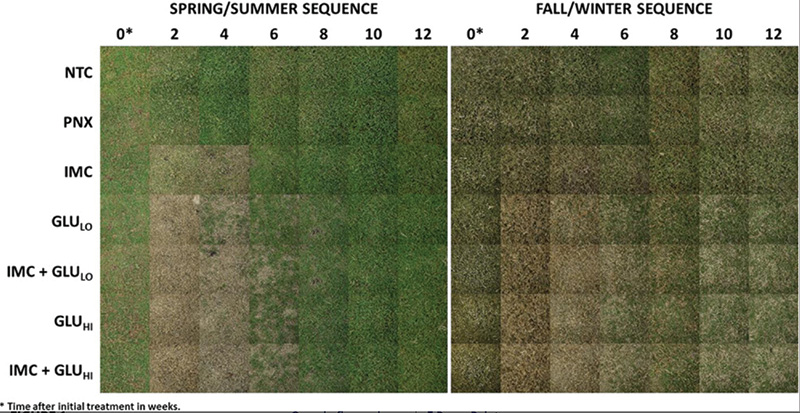
Visual representation of (left) spring- and (right) fall-applied herbicide treatments effect on green canopy cover in hybrid bermudagrass [Cynodon dactylon (L.) Pers. × C. trans-vaalensis Burtt-Davy] Tifway 419 maintained as an athletic field at the PFC Emory L. Bennett Veterans Memorial Park in Orange City, Fla., in 2023-2024.
Tropical signalgrass control in hybrid bermudagrass with glufosinate and imazapic tank-mixes
Tropical signalgrass (TSG [Urochloa distachya (L.) T.Q. Nguyen]) is difficult to control in Florida turfgrass due to limited herbicide options, perennial life cycle, aggressive growth and ability to reestablish from stolons and seeds. Field studies in central Florida were conducted in 2022 and 2023-2024 to identify effective herbicide combinations for controlling severe (i.e., ≥ 50% cover) TSG infestations in a hybrid bermudagrass [BGR Cynodon dactylon (L.) Pers. × C. trans-vaalensis Burtt-Davy] athletic field. Application timing (spring/summer [S/S Seq.] versus fall/winter [F/W Seq.]) and turfgrass recovery were also assessed. Herbicide treatments (topramezone [TPZ; 0.17 or 0.26 ounces per acre/12 or 18 grams per hectare], quinclorac [QNC; 12 ounces per acre/841 grams per hectare], amicarbazone [AMC; 2.5 or 3.6 ounces per acre/175 or 254 grams per hectare], imazapic [IMC; 1 ounce per acre/70 grams per hectare], glyphosate [GLY; 2 or 4 ounces per acre/140 or 280 grams per hectare], glufosinate [GLU; 7.9 or 12 ounces per acre/553 or 840 grams per hectare], pinoxaden [PNX; 2.2 ounces per acre/154 grams per hectare] and thiencarbazone + foramsulfuron + halosulfuron [TFH; 5 + 10 + 16 ounces per acre/355 + 710 + 1,105 grams per hectare]) were applied alone or combined every two weeks for a total of two applications, starting from Aug. 3, 2022, (Study 1) and May 18, 2023, or Oct. 11, 2023 (Study 2; PNX, IMC, and GLU only).
In Study 1, only PNX and GLU-based treatments effectively controlled TSG. Study 2 showed similar results, with IMC plus a low rate of GLU providing similar control to the higher rate of GLU alone. TSG removal was faster in the S/S Seq., but only the F/W Seq. consistently prevented reestablishment. GLU-based treatments caused rapid, severe BGR injury, though complete regeneration followed within six to eight weeks after initial treatment (WAIT). Recovery was slower with F/W Seq. in Study 2 compared to Study 1. This work was supported by the USDA National Institute of Food and Agriculture, Research Capacity Funds (Hatch) FLA-AGR-006207 to the Agronomy Department, University of Florida. The Florida GCSA, Florida Turfgrass Association, Turfgrass Producers of Florida and BASF supported this study and/or provided products.
— Pawel Petelewicz, Ph.D., (petelewicz.pawel@ufl.edu), Mikerly M. Joseph and Katarzyna A. Gawron, Agronomy Department, University of Florida, Gainesville; Gregory E. MacDonald, Ph.D., UF/Institute of Food and Agricultural Sciences Extension, Agronomy Department, Gainesville; and Karen Stauderman, IFAS Extension, University of Florida, Volusia County Office, DeLand

Photo by Darrell J. Pehr
Optimizing liquid-applied iron sulfate rate and application interval for dollar spot suppression on golf course fairways
Iron sulfate applications reduce dollar spot severity on golf course turfgrass, but further optimizing the use of iron sulfate may increase efficacy and encourage more widespread adoption by golf course superintendents. Three iron sulfate rates (8, 16 and 32 pounds per acre/9, 18 and 36 kilograms per hectare), two application intervals (seven and 14 days), three water volumes (33, 65 and 131 gallons per acre/306, 612 and 1,223 liters per hectare), and combinations with fertilizer and fungicide products were evaluated at field locations in Madison, Wis.; Bloomington, Minn.; and Blacksburg, Va.; in 2018 and 2019.
Iron sulfate rate decreased dollar spot at all locations in a dose-dependent manner, and seven-day applications were more efficacious than 14-day applications. Water volume had no impact on disease severity at any location, and combining iron sulfate with fertilizer had minimal impact as well. These results demonstrate improved iron sulfate strategies for dollar spot management and can be implemented by golf course superintendents in areas where fungicide resistance and fungicide regulations limit the use of traditional fungicides. Funding for portions of this work was provided by GCSAA, the Wisconsin Chapter of GCSAA and the Minnesota Chapter of GCSAA.
— Paul Koch, Ph.D. (plkoch@wisc.edu), Doug Soldat, Ph.D., and Kurt Hockemeyer, Department of Plant Pathology, University of Wisconsin–Madison; David McCall, Ph.D., School of Plant and Environmental Sciences, Virginia Tech University, Blacksburg; and Chase Straw, Ph.D., Department of Soil and Crop Sciences, Texas A&M University, College Station
Darrell J. Pehr (dpehr@gcsaa.org) is GCM’s science editor.